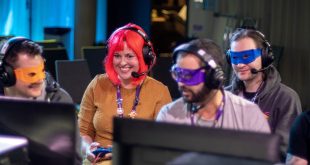20 years ago I commissioned an article in PC Zone magazine called Game & Able. It was intended as an oblique look at how well-served disabled gamers were by the industry at the time. I’ll be honest and say that my motivation for the article was mostly down to the fact that I’d not seen any on the subject before and it made a change from the usual six-page “exclusive” on whatever the next big thing was at the time. I had no intention to start a campaign, simply to profile an underrepresented group of gamers that I took to be every bit as passionate and invested in their hobby as everyone else.
What I didn’t expect to gain from the resulting article was an understanding of how capable these gamers were. There was the story of Barry Young, who, despite living with spinal muscular atrophy, was able to enjoy and compete in Team Fortress Classic and Half-Life thanks to his programmable Sidewinder Pro. Then there were the efforts of polio sufferer John LeDell, who had set up a community site for golf fans to play together online; among whom was Paul Willey, who despite having multiple sclerosis was considered the best Links player in the world at the time.
On the hardware side of things there was the Joybox out of Sweden and the Tracker 2000 from Canada, that between them allowed those with a range of severe physical disabilities to enjoy interactive entertainment in innovative ways. Also mentioned were titles like Grizzly Gulch and Shades of Doom, specifically designed for the visually impaired. All this was far from the mainstream, of course, but the existence of games, devices, and thriving online communities (including game review sites such as DeafGamers), was, for me, eye opening.
Unfortunately, the innovation, selflessness, and passion in and around the disabled gamer community was far from reflected by the industry at large. It’s fair to say that the comments in the article from the ELSPA (now Ukie) representative have not aged well. In response to criticism that games lacked accessibility features for the visually impaired came the line that “altering the lighting or colour scheme may be detrimental to the effect [publishers] are trying to achieve.” With regards to accessibility features generally, it was said that they would need to generate a “commercially favourable outcome” to be justified. Oh dear.
That was then and things have thankfully come a long way since. 20 years ago there was barely a recognition that disabled gamers existed, let alone could be catered for. Now we all know that developing features and functionality with disabled gamers in mind isn’t just the right thing to do, it can be profitable too.
There’s still a long way to go. Indeed, it may be that ensuring accessibility for all may be one of those goals that is forever out of reach, simply because it’s the nature of games to innovate. But that shouldn’t stop progress, which is why I hope that in the months ahead this page will be taken over by someone more qualified than me to hold the industry to account; to celebrate its success, and to highlight its failures, and to shine a light so that the ignorance and lack of engagement of 20 years ago remains forever locked in the pages of a forgotten magazine.
Want to help sponsor this feature in MCV/DEVELOP? Get in touch with alex.boucher@biz-media.co.uk

 MCV/DEVELOP News, events, research and jobs from the games industry
MCV/DEVELOP News, events, research and jobs from the games industry




